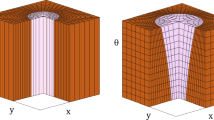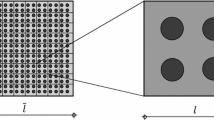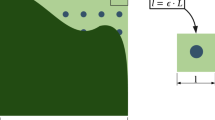Abstract
We extend the embedded unit cell (EUC) homogenization approach, to efficiently and accurately capture the multiscale solution of a solid with localized domains undergoing plastic yielding. The EUC approach is based on a mathematical homogenization formulation with non-periodic domains, in which the macroscopic and microscopic domain are concurrently coupled. The formulation consists of a theoretical derivation and the development of special boundary conditions representing the variations of the local displacement field across the unit cell boundaries. In particular, we introduce a restraining band surrounding the local domain in order to support the consistency of the solution in the transition layer between the micro and macro scales. The method is neither limited to a specific plasticity model nor to the number of localized features, thereby providing great flexibility in modeling. Several numerical examples illustrate that the proposed approach is accurate compared with direct finite element simulations, yet requires less computational cost.















Similar content being viewed by others
References
Gibson RF (2011) Principles of composite material mechanics. CRC Press, Boca Raton
Tadmor EB, Ortiz M, Phillips R (1996) Quasicontinuum analysis of defects in solids. Philos Mag A 73(6):1529–1563
Weinan E (2011) Principles of multiscale modeling. Cambridge University Press, Cambridge
Fish J (2006) Bridging the scales in nano engineering and science. J Nanoparticle Res 8(5):577–594
Fish J (2010) Multiscale methods: bridging the scales in science and engineering. Oxford University Press on Demand
Castañeda PP, Willis JR (1999) Variational second-order estimates for nonlinear composites Proc. R. Soc. London. Ser. A Math. Phys. Eng. Sci., vol. 455, no. 1985, pp. 1799–1811
Fish J, Shek K, Pandheeradi M, Shephard MS (1997) Computational plasticity for composite structures based on mathematical homogenization: theory and practice. Comput Methods Appl Mech Eng 148(1):53–73
Doghri I, Friebel C (2005) Effective elasto-plastic properties of inclusion-reinforced composites. Study of shape, orientation and cyclic response. Mech Mater 37(1):45–68
Doghri I, Brassart L, Adam L, Gérard J-S (2011) A second-moment incremental formulation for the mean-field homogenization of elasto-plastic composites. Int J Plast 27(3):352–371
Fish J, Fan R (2008) Mathematical homogenization of nonperiodic heterogeneous media subjected to large deformation transient loading. Int J Numer Methods Eng 76(7):1044–1064
Matouš K, Geubelle PH (2006) Multiscale modelling of particle debonding in reinforced elastomers subjected to finite deformations. Int J Numer Methods Eng 65(2):190–223
Agoras M, Castañeda PP (2011) Homogenization estimates for multi-scale nonlinear composites. Eur J Mech 30(6):828–843
Mosby M, Matouš K (2015) Hierarchically parallel coupled finite strain multiscale solver for modeling heterogeneous layers. Int J Numer Methods Eng 102(3–4):748–765
Hill R (1965) A self-consistent mechanics of composite materials. J Mech Phys Solids 13(4):213–222
Mandel J (1966) Conditions de stabilité et postulat de Drucker. Rheology and soil mechanics/Rhéologie et mécanique des sols. Springer, Berlin, pp 58–68
Kaleel I, Petrolo M, Carrera E, Waas AM (2019) Computationally efficient concurrent multiscale framework for the nonlinear analysis of composite structures. AIAA J 57(9):4029–4041
Talebi H, Silani M, Rabczuk T (2015) Concurrent multiscale modeling of three dimensional crack and dislocation propagation. Adv Eng Softw 80:82–92
Silani M, Ziaei-Rad S, Talebi H, Rabczuk T (2014) A semi-concurrent multiscale approach for modeling damage in nanocomposites. Theor Appl Fract Mech 74:30–38
Lu G, Tadmor EB, Kaxiras E (2006) From electrons to finite elements: a concurrent multiscale approach for metals. Phys Rev B 73(2):24108
Gracie R, Belytschko T (2011) An adaptive concurrent multiscale method for the dynamic simulation of dislocations. Int J Numer Methods Eng 86(4–5):575–597
Fish J (2011) Multiscale modeling and simulation of composite materials and structures. Multiscale methods in computational mechanics. Springer, Netherlands, pp 215–231
Zhang X, Oskay C (2017) Sparse and scalable eigenstrain-based reduced order homogenization models for polycrystal plasticity. Comput Methods Appl Mech Eng 326:241–269
Matouš K, Geers MGD, Kouznetsova VG, Gillman A (2017) A review of predictive nonlinear theories for multiscale modeling of heterogeneous materials. J Comput Phys 330:192–220
Guo N, Zhao J (2014) A coupled FEM/DEM approach for hierarchical multiscale modelling of granular media. Int J Numer Methods Eng 99(11):789–818
Bouvard JL, Ward DK, Hossain D, Nouranian S, Marin EB, Horstemeyer MF Review of hierarchical multiscale modeling to describe the mechanical behavior of amorphous polymers. J Eng Mater Technol, vol. 131, no. 4, 2009.
Geers MGD, Kouznetsova VG, Brekelmans WAM (2010) Multi-scale computational homogenization: trends and challenges. J Comput Appl Math 234(7):2175–2182
Chun J, Ahn S Bengio Y (2016) Hierarchical multiscale recurrent neural networks. arXiv Prepr. arXiv1609.01704
Wu W, Yuan Z, Fish J (2010) Eigendeformation-based homogenization of concrete. Int J Multiscale Comput Eng 8(1):1–15
Tabarraei A, Song J-H, Waisman H (2013) A two-scale strong discontinuity approach for evolution of shear bands under dynamic impact loads. Int J Multiscale Comput Eng 11(6):543–563
V. G. Kouznetsova (2004) Computational homogenization for the multi-scale analysis of multi-phase materials
Yuan Z, Fish J (2008) Toward realization of computational homogenization in practice. Int J Numer Methods Eng 73(3):361–380
Geers MGD, Coenen EWC, Kouznetsova VG (2007) Multi-scale computational homogenization of structured thin sheets. Model Simul Mater Sci Eng 15(4):S393
Wu L, Noels L, Adam L, Doghri I (2013) A combined incremental-secant mean-field homogenization scheme with per-phase residual strains for elasto-plastic composites. Int J Plast 51:80–102
Prasad NE, Srivatsan TS, Wanhill RJH, Malakondaiah G, Kutumbarao VV (2014) Fatigue behavior of aluminum-lithium alloys. Elsevier, Amsterdam, pp 341–379
Geers M, Kouznetsova VG, Brekelmans WAM (2003) Multiscale first-order and second-order computational homogenization of microstructures towards continua. Int J Multiscale Comput Eng 1(4):371–386
Kouznetsova V, Geers MGD, Brekelmans WAM (2002) Multi-scale constitutive modelling of heterogeneous materials with a gradient-enhanced computational homogenization scheme. Int J Numer Methods Eng 54(8):1235–1260
de Souza Neto EA, Peric D, Owen DRJ (2011) Computational methods for plasticity: theory and applications. John Wiley & Sons, Hoboken
Ghosh S, Moorthy S (1995) Elastic-plastic analysis of arbitrary heterogeneous materials with the Voronoi Cell finite element method. Comput Methods Appl Mech Eng 121(1–4):373–409
Doghri I, Ouaar A (2003) Homogenization of two-phase elasto-plastic composite materials and structures: study of tangent operators, cyclic plasticity and numerical algorithms. Int J Solids Struct 40(7):1681–1712
Kelly P (2013) Solid mechanics. Part II, Lecture notes, The University of Auckland
Andrianopoulos NP, Manolopoulos VM (2014) Elastic strain energy density decomposition in failure of ductile materials under combined torsion-tension. Int J Mech Mater Eng 9(1):1–12
Lemaitre J (2001) Handbook of materials behavior models, three-volume set: nonlinear models and properties. Elsevier, Amsterdam
Suganuma K (2018) Wide bandgap power semiconductor packaging: materials, components, and reliability. Woodhead Publishing, Cambridge
Belytschko T, Loehnert S, Song JH (2008) Multiscale aggregating discontinuities: a method for circumventing loss of material stability. Int J Numer Methods Eng 73(6):869–894. https://doi.org/10.1002/nme.2156
Song JH, Belytschko T (2009) Multiscale aggregating discontinuities method for micro-macro failure of composites. Compos Part B Eng 40(6):417–426. https://doi.org/10.1016/j.compositesb.2009.01.007
Grigorovitch M, Gal E (2017) Homogenization of non-periodic zones in periodic domains using the embedded unit cell approach. Comput Struct 179:95–108
M. Grigorovitch and E. Gal, “The local response in structures using the Embedded Unit Cell Approach,” Comput. Struct., vol. 157, 2015, doi: https://doi.org/10.1016/j.compstruc.2015.05.006.
Song JH, Yoon YC (2014) Multiscale failure analysis with coarse-grained micro cracks and damage. Theor Appl Fract Mech 72(1):100–109. https://doi.org/10.1016/j.tafmec.2014.04.005
Belytschko T, Song JH (2010) Coarse-graining of multiscale crack propagation. Int. J. Numer Methods Eng 81(5):537–563. https://doi.org/10.1002/nme.2694
“Abaqus.” [Online]. Available: https://www.3ds.com/products-services/simulia/products/abaqus/.
Gal E, Yuan Z, Wu W, Fish J (2007) A multiscale design system for fatigue life prediction. Int. J. Multiscale Comput Eng. 5(6):435–446
Fish J, Wagiman A (1993) Multiscale finite element method for a locally nonperiodic heterogeneous medium. Comput Mech 12(3):164–180. https://doi.org/10.1007/BF00371991
Allaire G, Briane M (1996) Multiscale convergence and reiterated homogenisation. Proc R Soc Edinburgh Sect A Math 126(2):297–342
Ryvkin M, Hadar O, Kucherov L (2017) Multiscale analysis of non-periodic stress state in composites with periodic microstructure. Int J Eng Sci 121:167–181
Geers MGD, Yvonnet J (2016) Multiscale modeling of microstructure–property relations. MRS Bull 41(8):610–616
Sridhar A, Kouznetsova VG, Geers MGD (2018) A general multiscale framework for the emergent effective elastodynamics of metamaterials. J Mech Phys Solids 111:414–433
Geers MGD, Kouznetsova VG, Matouš K, Yvonnet J (2017) Homogenization methods and multiscale modeling: nonlinear problems. Encyclopaedia of scomputational mechanics. John & Wiley sons, Chichester, pp 1–34
Dolbow JE (2000) An extended finite element method with discontinuous enrichment for applied mechanics
Samimi M, Van Dommelen JAW, Geers MGD (2009) An enriched cohesive zone model for delamination in brittle interfaces. Int J Numer Methods Eng 80(5):609–630
Waseem A, Heuzé T, Stainier L, Geers MGD, Kouznetsova VG (2021) Two-scale analysis of transient diffusion problems through a homogenized enriched continuum. Eur J Mech 87:104212
Fish J, Yuan Z (2007) Multiscale enrichment based on partition of unity for nonperiodic fields and nonlinear problems. Comput Mech 40(2):249–259
Oskay C (2013) Variational multiscale enrichment method with mixed boundary conditions for modeling diffusion and deformation problems. Comput Methods Appl Mech Eng 264:178–190
Gupta V, Duarte CA, Babuška I, Banerjee U (2013) A stable and optimally convergent generalized FEM (SGFEM) for linear elastic fracture mechanics. Comput Methods Appl Mech Eng 266:23–39
Kim D, Pereira JP, Duarte CA (2010) Analysis of three-dimensional fracture mechanics problems: a two-scale approach using coarse-generalized FEM meshes. Int J Numer Methods Eng 81(3):335–365
Pereira JP, Duarte CA, Guoy D, Jiao X (2009) hp-Generalized FEM and crack surface representation for non-planar 3-D cracks. Int J Numer Methods Eng 77(5):601–633
Hiriyur B, Tuminaro RS, Waisman H, Boman EG, Keyes DE (2012) A quasi-algebraic multigrid approach to fracture problems based on extended finite elements. SIAM J Sci Comput 34(2):A603–A626
Gerstenberger A, Tuminaro RS (2013) An algebraic multigrid approach to solve extended finite element method based fracture problems. Int J Numer Methods Eng 94(3):248–272
Dvorak GJ (1900) Transformation field analysis of inelastic composite materials. Proc R Soc Lond A 1992(437):311–327
Matouš K (2003) Damage evolution in particulate composite materials. Int J Solids Struct 40(6):1489–1503
Fritzen F, Leuschner M, Hodapp M (2015) Nonlinear homogenization using model order reduction: two-scale simulations and novel developments using the pRBMOR on GPUs
Covezzi F, de Miranda S, Fritzen F, Marfia S, Sacco E (2018) Comparison of reduced order homogenization techniques: pRBMOR, NUTFA and MxTFA. Meccanica 53(6):1291–1312
Roussette S, Michel J-C, Suquet P (2009) Nonuniform transformation field analysis of elastic–viscoplastic composites. Compos Sci Technol 69(1):22–27
Michel J-C, Suquet P (2016) A model-reduction approach in micromechanics of materials preserving the variational structure of constitutive relations. J Mech Phys Solids 90:254–285
Monaldo E, Marfia S (2021) Computational homogenization of 3D printed materials by a reduced order model. Int J Mech Sci 197:106332
Covezzi F, de Miranda S, Marfia S, Sacco E (2016) A HOMOGENIZATION TECHNIQUE FOR ELASTO-PLASTIC COMPOSITES.”
Oskay C, Fish J (2007) Eigendeformation-based reduced order homogenization for failure analysis of heterogeneous materials. Comput Methods Appl Mech Eng 196(7):1216–1243
Yuan Z, Jiang T, Fish J, Morscher G (2014) Reduced-order multiscale-multiphysics model for heterogeneous materials. Int. J. Multiscale Comput Eng 12(1):45–64
Zhuang X, Wang Q, Zhu H (2015) A 3D computational homogenization model for porous material and parameters identification. Comput Mater Sci 96:536–548
Jeong S, Zhu F, Lim H, Kim Y, Yun GJ (2019) 3D stochastic computational homogenization model for carbon fiber reinforced CNT/epoxy composites with spatially random properties. Compos Struct 207:858–870. https://doi.org/10.1016/j.compstruct.2018.09.025
Jain JR, Ghosh S (2009) Damage evolution in composites with a homogenization-based continuum damage mechanics model. Int J Damage Mech 18(6):533–568
Duarte CA, Babuška I, Oden JT (2000) Generalized finite element methods for three-dimensional structural mechanics problems. Comput Struct 77(2):215–232
Galvanetto U, Aliabadi MHF (2009) Multiscale modeling in solid mechanics: computational approaches, 3rd edn. Imperial College Press, London
Babuška I (1976) Homogenization and its application. Mathematical and computational problems. Numerical solution of partial differential equations–III. Academic Press, Cambridge, pp 89–116
Bensoussan A, Lions J-L, Papanicolaou G (2011) Asymptotic analysis for periodic structures, vol 374. American Mathematical Soc, Providence, Rhode Island
Sanchez-Palencia E (1983) Homogenization method for the study of composite media. Asymptotic analysis II. Springer, Cham, pp 192–214
Panasenko GP (2005) Multi-scale modelling for structures and composites. Springer, Cham
Grigorovitch M, Gal E (2015) The local response in structures using the Embedded Unit Cell Approach. Comput Struct 157:189–200
Kelly P (2013) Solid mechanics. Lect. notes, Univ. Auckl, Auckland
Funding
No funding was received to assist with the preparation of this manuscript. No funding was received for conducting this study.
Author information
Authors and Affiliations
Contributions
Marina Grigorovitch, Erez Gal and Haim Waisman contributed to the design and implementation of the research, to the analysis of the results and to the writing of the manuscript.
Corresponding author
Ethics declarations
Conflict of interest
All authors certify that they have no affiliations with or involvement in any organization or entity with any financial interest or non-financial interest in the subject matter or materials discussed in this manuscript. The authors have no financial or proprietary interests in any material discussed in this article.
Ethical approval
This manuscript does not contain any studies with human participants or animals performed by any of the authors.
Additional information
Publisher's Note
Springer Nature remains neutral with regard to jurisdictional claims in published maps and institutional affiliations.
Rights and permissions
About this article
Cite this article
Grigorovitch, M., Gal, E. & Waisman, H. Embedded unit cell homogenization model for localized non-periodic elasto-plastic zones. Comput Mech 68, 1437–1456 (2021). https://doi.org/10.1007/s00466-021-02077-3
Received:
Accepted:
Published:
Issue Date:
DOI: https://doi.org/10.1007/s00466-021-02077-3




